
Water Transit Scores
Ferries Get a Home Run in
Transportation Spending Bill
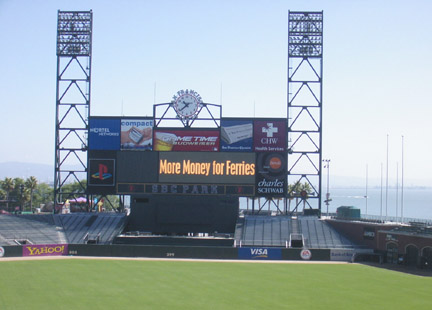 The
passage of Regional Measure 2 in the Bay Area’s March 2
election secures money for more ferries along with more than
30 other transportation projects around the region. For
ferries, it will make possible new routes between San
Francisco and the cities of Berkeley and South San
Francisco. Also, RM 2 will buy more boats for the already
existing Alameda/Oakland line, subsidize operations for the
Vallejo route, and add more berths at San Francisco’s
Downtown Ferry Terminal to accommodate the expected growth
in ferry traffic. Planning monies will become available for
Richmond and Port Sonoma. The measure carried long-awaited
operating funds for Vallejo/Baylink’s third boat scheduled
to arrive this year.
The
passage of Regional Measure 2 in the Bay Area’s March 2
election secures money for more ferries along with more than
30 other transportation projects around the region. For
ferries, it will make possible new routes between San
Francisco and the cities of Berkeley and South San
Francisco. Also, RM 2 will buy more boats for the already
existing Alameda/Oakland line, subsidize operations for the
Vallejo route, and add more berths at San Francisco’s
Downtown Ferry Terminal to accommodate the expected growth
in ferry traffic. Planning monies will become available for
Richmond and Port Sonoma. The measure carried long-awaited
operating funds for Vallejo/Baylink’s third boat scheduled
to arrive this year.
“It’s a great victory for Bay
Area commuters who drive, use transit or want to use
transit,” said State Senate Majority Leader Don Perata
(D-Oakland), author of Measure 2. “Voters took matters into
their own hands. They want better transit.”
A majority of Bay Area voters
agreed that paying a dollar extra toll on all Bay Area
bridges, with the exception of the Golden Gate Bridge, was a
good idea – so long as that money is dedicated to regional
traffic relief. Alameda, Contra Costa, Marin, San Francisco,
San Mateo and Santa Clara all approved the measure by a
majority vote.
| |
|
“We are delighted that ferries
are part of the biggest transportation
investment that this region has made in over a
decade!”
Charlene Haught Johnson,
President, WTA |
| |
“We are delighted that
ferries are part of the biggest transportation investment
that this region has made in over a decade! We look forward
to serving Bay Area communities by delivering new ferry
boats and new terminals,” said Charlene Haught Johnson,
president, San Francisco Bay Area Water Transit Authority (WTA).
“Regional Measure 2 provides
the money to jumpstart this long-awaited ferry expansion,”
added Steve Castleberry, the WTA’s chief executive officer.
“The Bay Area currently has the third largest commuter ferry
system in the country. By investing in our ferry system, we
can get more people out of their cars and onto ferries.” The
WTA’s studies showed that the number of ferry riders will
triple by 2025 for a total of 12 million passenger trips per
year with expanded service.
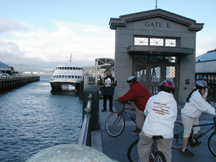 |
|
Inlandboatmen’s Union member Stefan Dimitrov
(far left) passed out fliers educating ferry
riders about the importance of Regional Measure
2 for the future of ferries. |
Ferry Crews Celebrate
Victory for Ferries
Transit agencies around the region educated voters on what
RM 2 would mean for their commute by handing out fliers near
terminals and transit stops. Ferryboat workers, organized
through the Inlandboatmen’s Union of the Pacific (IBU),
reached out to ferry riders. According to deckhands Kiante
London and Steve Ongerth, passage of RM 2 “means more jobs
and better mass transit. The existing ferry service will
increase.” They, along with other members of the crew,
donated money and time to promoting RM 2 among friends and
ferry passengers.
Regarding the varying degrees
of support among the counties, Mr. Ongerth said that the
Marin County showing of support at a comparably high 63.8%
surprised him and that Solano’s low vote tally was
disappointing,
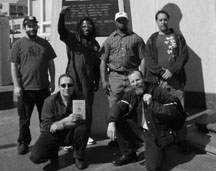 |
|
Inlandboatmen’s union crew members shared a
celebratory moment after RM 2 passed. From left:
Steve Ongerth, Stefan Dimitrov, William Golson,
Kiante London, Jack Westlie, Luis Arevalo. |
especially given that it will
fund more Vallejo ferry service. Mr. London stressed the
need for both buses and boats since landside connections are
critical for transferring people to their final destination.
|
How Bay Area counties voted
on RM 2
Statewide:
56.6% Yes
Alameda:
54.4% Yes
Contra Costa: 51.1% Yes
Marin:
63.8% Yes
San Francisco: 68.9% Yes
San Mateo: 54.9%
Yes
Santa Clara: 58.8% Yes
Solano:
40.9% Yes |
Security and public safety
are top priorities for deckhands, explained IBU member
William Golson. The crew’s readiness to respond to fires,
instances of man-overboard, and other onboard emergencies
may partially explain why people riding Bay Area ferries are
riding the region’s safest form of public transit. According
to Luis Arevalo’s experience on a crew, deckhands even help
recreational users, with whom they share the Bay. For
instance, Mr. Arevalo once fished a struggling windsurfer
out of the water.
 |
| Marina
Secchitano (r), Regional Director of Inland
Boatmen’s Union of the Pacific (IBU) joined
Democratic presidential candidate Senator John
Kerry. The IBU represents most of the crew
people working San Francisco Bay ferryboats.
Also present were Gunnar Lundeberg (l),
president, Sailors’ Union of the Pacific; and
Art Pulaski, executive secretary/treasurer,
California Labor Federation. On a tight campaign
schedule, Senator Kerry opted to take a ferry
from one side of the Bay to the other to avoid
rush-hour traffic between San Francisco and
Oakland’s Jack London square. |
Next Inning for Ferries:
Scoring Federal and Local Dollars
Although money from Regional
Measure 2 (RM 2) gives a good boost to boats, it falls short
of funding the entire San Francisco Bay Area Water Transit
Authority’s (WTA) plan for new ferries. It funds two out of
the WTA’s recommended seven new routes. The WTA is looking
to federal grants to fill funding gaps.
The Bay Area has the third
largest commute system and the WTA is seeking to bring more
ferry dollars to this region. Washington, Alaska, and New
Jersey benefit from large set-asides from the Federal
Ferryboat grant program.
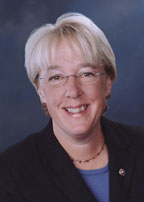 |
| Senator
Patty Murray took the lead on sponsoring the
Senate amendment to increase the federal dollars
for ferries. |
Federal Leaders Join in
Ferry Excitement
Senator Patty Murray (D-WA), joined by Senators Diane
Feinstein (D-San Francisco) and Barbara Boxer (D-San
Francisco), successfully amended the Senate surface
transportation reauthorization (SAFE TEA) by more than
tripling the Federal Ferryboat Discretionary (FBD) Program
from $38 million to $120 million per year.
Senator Murray said, “My
amendment recognizes the importance of ferries to our
nation’s transportation infrastructure and provides the
resources and support they need to grow. If we don’t expand
our investment in ferries as demand soars, we will feel the
same impacts we feel when a road is overcrowded. We will
lose jobs, productivity and handicap our economic growth. By
increasing our ferry investment, we can reap big rewards for
commuters, manufacturers, and our economy.”
| |
|
“By increasing our ferry
investment, we can reap big rewards for
commuters, manufacturers, and our economy.”
Sen. Patty Murray (D-WA) |
| |
On the House side,
Representative Don Young (R-AK), Chairman of Transportation
and Infrastructure, has been a tremendous advocate for
ferries. Specifically, he championed the necessary House
amendment of the
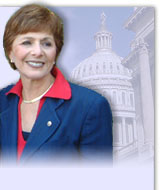 |
| Senator
Barbara Boxer along with Senators Murray and
Feinstein, co-authored an amendment to the
Federal Ferryboat Discretionary Program to
increase the pot of money for ferries from $38
million to $120 million annually. |
TEA bill, including $100
million/year for the FBD, increasing by $5 million/year, to
$125 million in the sixth year of his TEA bill. If approved,
this would be an impressive three-fold increase in federal
support for public ferry systems. Chairman Young is moving
forward to markup the TEA bill this month, with the
objective of getting to conference with the Senate (with its
$120 million/year FBD) before the current two-month
extension of TEA expires by May.
| |
|
“Congestion will not get
better over time. California’s population is
expected to increase from 35 million people
today to 50 million people by 2020. We need to
make great strides in our transportation
system.”
Sen. Barbara Boxer
(D-San Francisco) |
| |
This last year,
Representative Tom Lantos (D-San Mateo) obtained $1 million
in federal dollars for the South San Francisco ferry. This
grant was the only grant of ferry funds that came to
California that year. In FY ’05, he will submit a request
for another appropriation of Federal Ferry Boat
Discretionary funds for $2.5 million to cover costs of a
third ferry vessel.
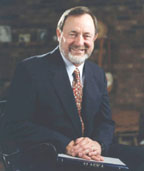 |
| Rep. Don
Young (R-AK): advocating to increase federal
ferryboat money in the TEA bill |
Launching New Ferry
Service– What Next?
This year, the WTA will begin doing site-specific design,
planning, and environmental studies funded by RM 2. Using
modular designs and working with the individual communities
to personalize them, the WTA will help to build
| |
“Traffic congestion in
California costs motorists $20.4 billion
annually in lost time and fuel. San Francisco
and Oakland are tied for second place [in having
the worst traffic in the nation]. California
needs money for public transit to reduce the
amount of cars on the road, reducing air
pollution, and decreasing the amount of time my
constituents have to spend commuting every day.”
Sen. Diane Feinstein (D-San
Francisco) |
| |
terminals for South San
Francisco, Richmond, and Berkeley: services that have RM 2
funding. It will also continue planning for Redwood City,
Treasure Island, Port Sonoma, Hercules, and
Antioch/Martinez. The WTA hopes to deliver new,
environmentally responsive boats as early as 2007.
The WTA’s ten-year plan
includes new ferry routes to Berkeley, Richmond, Treasure
Island, Antioch-Martinez, Hercules, South San Francisco, and
Redwood City, and expansion of the existing routes serving
Vallejo, Sausalito, Larkspur, Oakland, Alameda and Harbor
Bay Island. To fill funding gaps not addressed in RM 2, the
WTA will be working with communities on reserving local
sales tax dollars for ferries and seeking transit impact
fees from developers. Both Contra Costa and San Mateo
counties are expected to include money for ferries in their
local transportation sales tax measures that will go to a
vote as early as November 2004.
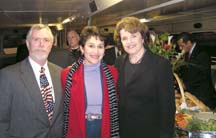 |
On the
campaign trail with presidential candidate
Senator John Kerry, Diane Feinstein (r )
discovered the ease of taking public transit–on
a ferry! She was joined by the president of Blue
and Gold fleet, Ron Duckhorn (l), and the WTA’s
Veronica Sanchez.
Senator Feinstein, sitting on the powerful
Senate Appropriations Committee, successfully
pushed for federal grant money for Oyster Point
ferry service. |